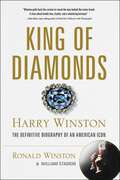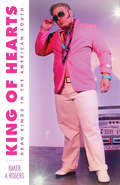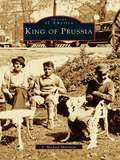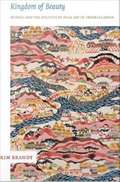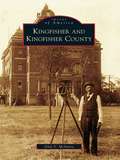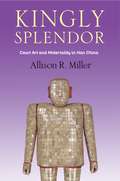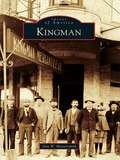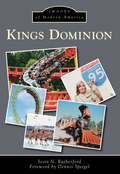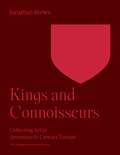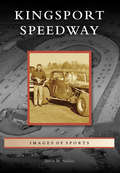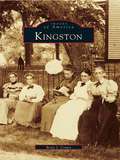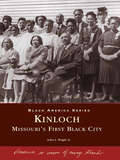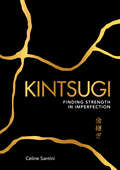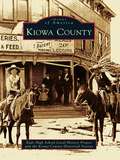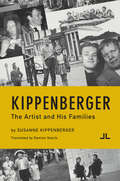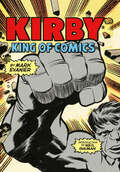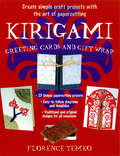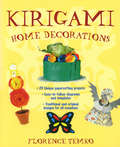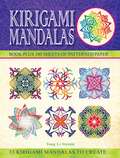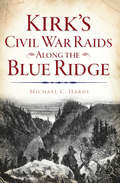- Table View
- List View
King of Diamonds: Harry Winston, the Definitive Biography of an American Icon
by William Stadiem Ronald WinstonThis authoritative and intimate biography, written by his only living son, Ronald Winston, marries the Gilded Age glamour and romance of Edith Wharton with the ruthless family dynamics of HBO&’s hit series, Succession. Few American success stories rival that of Harry Winston. Born Harry Weinstein, he came from humble roots—his parents were poor Jewish immigrants who left Ukraine around 1890 for New York, where they settled and started a small jewelry business. His genius for spotting priceless gems emerged young. When Harry was twelve years old, he recognized a two-carat emerald in a pawn shop and bought it for 25 cents, selling it two days later for $800—a massive sum in the early 1900s. From that moment on, Harry became obsessed with gems, especially diamonds. A compact, unassuming man with no formal education, but unlimited drive and ambition, Harry Weinstein transformed himself into Harry Winston, the enigmatic figure who created the world&’s most prestigious luxury brand. Harry Winston built his empire while the Depression raged, World War II reshaped the world, and America entered its post-war period of prosperity. In this riveting biography, readers get a bird&’s eye view of the dangers of the diamond trade and the lengths men would go to get their hands on the best of the &“rough.&” There&’s also a glimpse into the lives of the rich and famous, who clamored for Winston&’s gems. Although he traveled the world doing business with kings, queens, and movie stars, Winston remained a devoted family man, whose chief wish was that his sons carry on the legacy he had built. Harry&’s older son Ronald Winston worked alongside his father for decades. After Harry&’s death, Ron grew the company into the international brand that is still revered today. He ran it expertly, until he was forced to sell the company, due to his younger brother&’s maligning litigation. This is the story of a family business that survived and thrived for more than a century, until it was undone by one, bitter family member. KING OF DIAMONDS is at once a portrait of American ingenuity at its best, and the story of sibling rivalry that is Shakespearean in its tragedy.
King of Hearts: Drag Kings in the American South
by Baker A. RogersWhile drag subcultures have gained mainstream media attention in recent years, the main focus has been on female impersonators. Equally lively, however, is the community of drag kings: cis women, trans men, and non-binary people who perform exaggerated masculine personas onstage under such names as Adonis Black, Papi Chulo, and Oliver Clothesoff. King of Hearts shows how drag king performers are thriving in an unlikely location: Southern Bible Belt states like Tennessee, Georgia, and South Carolina. Based on observations and interviews with sixty Southern drag kings, this study reveals how they are challenging the region’s gender norms while creating a unique community with its own distinctive Southern flair. Reflecting the region’s racial diversity, it profiles not only white drag kings, but also those who are African American, multiracial, and Hispanic. Queer scholar Baker A. Rogers—who has also performed as drag king Macon Love—takes you on an insider’s tour of Southern drag king culture, exploring its history, the communal bonds that unite it, and the controversies that have divided it. King of Hearts offers a groundbreaking look at a subculture that presents a subversion of gender norms while also providing a vital lifeline for non-gender-conforming Southerners.
King of Prussia
by J. Michael MorrisonKing of Prussia hosts over 10 million visitors annually. This is quite a change from the little town once described as resembling an English hamlet. By 1762, King of Prussia had already become an area of strategic importance. Only a day's ride from Philadelphia, it was often used as a staging area for travelers heading west.
King of the Tightrope: When the Great Blondin Ruled Niagara
by Donna Janell BowmanIn 1859, The Great Blondin took the most dangerous tightrope walk of his career—a death-defying walk across Niagara Falls. History and STEAM combine for an edge-of-your-seat read. At the age of four, Jean-Francois Gravelet walked across his first balance beam. Later, he took to the tightrope like a spider to its web and climbed toward stardom. Though his feats became more and more marvelous, he grew bored. That is, until he visited Niagara Falls and imagined doing something that no one else had ever accomplished.To cross the raging river, the Great Blondin needed determination, an understanding of engineering, and a belief that what he could imagine, he could accomplish. And in 1859, with all of his preparation complete, Blondin stepped out onto the most dangerous tightrope walk he'd ever faced.Award-winning nonfiction author Donna Janell Bowman uses her trademark in-depth research to give readers a close look at the hard work and meticulous mathematic and scientific planning it took to plan and execute and astonish feat. Adam Gustavson's detailed illustrations turn this book into an experience that will astound and inspire. This fascinating, STEAM-filled story will have readers holding their breath!
Kingdom of Beauty: Mingei and the Politics of Folk Art in Imperial Japan
by Kim BrandtA Study of the Weatherhead East Asian Institute, Columbia University Kingdom of Beauty shows that the discovery of mingei (folk art) by Japanese intellectuals in the 1920s and 1930s was central to the complex process by which Japan became both a modern nation and an imperial world power. Kim Brandt's account of the mingei movement locates its origins in colonial Korea, where middle-class Japanese artists and collectors discovered that imperialism offered them special opportunities to amass art objects and gain social, cultural, and even political influence. Later, mingei enthusiasts worked with (and against) other groups--such as state officials, fascist ideologues, rival folk art organizations, local artisans, newspaper and magazine editors, and department store managers--to promote their own vision of beautiful prosperity for Japan, Asia, and indeed the world. In tracing the history of mingei activism, Brandt considers not only Yanagi Muneyoshi, Hamada Shōji, Kawai Kanjirō, and other well-known leaders of the folk art movement but also the often overlooked networks of provincial intellectuals, craftspeople, marketers, and shoppers who were just as important to its success. The result of their collective efforts, she makes clear, was the transformation of a once-obscure category of pre-industrial rural artifacts into an icon of modern national style.
Kingfisher and Kingfisher County
by Glen V. McintyreKingfisher and Kingfisher County showcases images from a special time, 1889 to just before World War II, and special places, small towns on the edge of the Great Plains. Sometimes called "the Buckle of the Wheat Belt," the city of Kingfisher is the county seat and lies about 45 minutes northwest of Oklahoma City near the center of the state. Other towns, Hennessey, Loyal, Cashion, Dover, and Okarche, still exist and thrive, although many other small towns in the county are only memories. The eastern portion of the county was opened by the land run of 1889, and the western portion, originally part of the Cheyenne and Arapaho Reservation, was opened by the land run of 1892. The growth and harvesting of hard red winter wheat has long been central to the economy of the area. Photographs of Cheyenne Indians, floods, wheat harvesting, small-town stores, and the people of the area are only some of the materials that preserve showing the way life was in Kingfisher and Kingfisher County.
Kingly Splendor: Court Art and Materiality in Han China (Tang Center Series in Early China)
by Allison R. MillerThe Western Han dynasty (202 BCE–9 CE) was a foundational period for the artistic culture of ancient China, a fact particularly visible in the era’s funerary art. Iconic forms of Chinese art such as dazzling suits of jade; cavernous, rock-cut mountain tombs; fancifully ornate wall paintings; and armies of miniature terracotta warriors were prepared for the tombs of the elite during this period. Many of the finest objects of the Western Han have been excavated from the tombs of kings, who administered local provinces on behalf of the emperors.Allison R. Miller paints a new picture of elite art production by revealing the contributions of the kings to Western Han artistic culture. She demonstrates that the kings were not mere imitators of the imperial court but rather innovators, employing local materials and workshops and experimenting with new techniques to challenge the artistic hegemony of the imperial house. Tombs and funerary art, Miller contends, functioned as an important vehicle of political expression as kings strove to persuade the population and other elites of their legitimacy. Through case studies of five genres of royal art, Miller argues that the political structure of the early Western Han, with the emperor as one ruler among peers, benefited artistic production and innovation. Kingly Splendor brings together close readings of funerary art and architecture with nuanced analyses of political and institutional dynamics to provide an interdisciplinary revisionist history of the early Western Han.
Kingman
by Dan W. MessersmithKingman, county seat of Mohave County in northwestern Arizona, owes its beginning and subsequent prosperity to the building of the Atlantic and Pacific Railroad in 1882. The city was named for the project's chief engineer, Lewis Kingman. The initial railroad siding quickly became a supply center for mining and ranching operations that dotted the beautiful surrounding valleys and mountain ranges. Through the years, Kingman has been at the crossroads of rail, highway, and air transportation routes. A B-17 bomber gunnery training base brought changes by exposing the area's potential to thousands of soldiers during World War II, many of whom would later return. Actor Andy Devine grew up here, Clark Gable and Carole Lombard were married here, and Charles Lindbergh would establish a route for Transcontinental Air Transport through here. Today Kingman is the "Heart of Historic U.S. Route 66" and is located in the middle of the longest remaining stretch of the "Mother Road," making it a must-see destination for thousands of tourists each year.
Kings Dominion
by Dennis Speigel Scott N. RutherfordKings Dominion officially opened in 1975 on a 400-acre site between Richmond, Virginia, and Washington, DC. Modeled on sister park Kings Island in Ohio, it debuted with several iconic attractions, including the Eiffel Tower, Rebel Yell, and Lion Country Safari. Over the decades, ownership has changed several times, yet the park continues to grow and remain popular, even "starring" in the 1977 film Rollercoaster. Now celebrating its 40th anniversary, it has evolved into one of North America's premier regional theme parks and is currently home to an impressive assortment of attractions and live entertainment. The park also boasts a formidable arsenal of roller coasters (14), including four of the wooden variety, three LIM-launched coasters, and the 30-story-tall Intimidator (I-305) giga coaster.
Kings and Connoisseurs: Collecting Art in Seventeenth-Century Europe (The A. W. Mellon Lectures in the Fine Arts #43)
by Jonathan BrownA vivid and exciting account of royal collectors, art dealers, connoisseurs, and the rise of old master paintingsOld master paintings are among the most valuable and prestigious of the visual arts, and the best examples command the highest prices of any luxury commodity. In Kings and Connoisseurs, Jonathan Brown tells the story of how painting rose to this exalted status. The transformation of painting from an inexpensive to a costly art form reached a crucial stage in the royal courts of Europe in the seventeenth century, where rulers and aristocrats assembled huge collections, often in short periods of time. By comparing collecting and collectors at these courts, Brown explains the formation of new attitudes toward pictures, as well as the mechanisms that supported the enterprise of collecting, including the emergence of the art dealer, the development of connoisseurship, and the publication of sumptuous picture books of various collections. The result is an exciting narrative of greed and passion, played out against a background of international politics and intrigue.
Kingsport Speedway (Images of Sports)
by David M. McgeeKingsport Speedway has hosted many of racing's greatest drivers, whether its track surface was asphalt, red clay, or brushed concrete. The short track, located in East Tennessee, has undergone dramatic changes since 1965 in attempts to keep pace with an ever-evolving motorsports landscape while entertaining three generations of fans. Hall of Fame members have raced and won at Kingsport Speedway, as did a contingent of regional stars. Today, Kingsport Speedway features weekly programs of NASCAR's Whelen All-American Series, which crowns track, state, regional, and national champions.
Kingston
by Betty J. CotterPerhaps no village in Rhode Island can boast the history of Kingston, or "Little Rest" as it was called. Once a seat of government (its library was one of Rhode Island's five state houses), Kingston has been home to some of the state's most illustrious residents as well as the now sprawling University of Rhode Island. A center of intellectual life long before the university began, Kingston was characterized by social, civic, and dramatic clubs, academies for both men and women, taverns for the weary traveler, and an imposing church atop Kingston Hill whose influence was felt broadly in the village.More than 200 photographs take the reader back tonineteenth-century Kingston, where Stephen Knowles waits atop his carriage to take travelers to Kingston Station, hat maker Cyrus French regales the menfolk in Joe Reynolds's tavern with his expansivestories, and the villagers gather on a summer evening to listen to a musicale on the library's lawn. Within Kingston's pages, the reader can meet people like Solomon Fayerweather, the village blacksmith and church sexton with a unique wisdom about village doings; and Quaker Billy Rose, whose fine weaving work was sought by the likes of Mrs.Theodore Roosevelt. See the familiar, Colonial-style houses that still line Kingstown Road as well as others that have fallen victim to the wrecking ball. Photographs of nearby "Biscuit City" and West Kingston are also included. These photographs, mostly from the collection of the Pettaquamscutt Historical Society, chronicle church, school, and business life in this picturesque village that has played such an important role in Rhode Island's history.
Kinloch: Missouri's First Black City (Black America Series)
by John A. Wright Sr.Located just outside of St. Louis, Kinloch was once a community locked off from the rest of the area by natural and man-made barriers. In spite of a lack of financial resources, it once provided its residents with a school district, city hall, post office, business district, and recreational facilities. Residents will recognize Dunbar Elementary, the oldest school for blacks in St. Louis County, Holy Angels, the oldest continuing black parish in the St. Louis Archdiocese, as well as former residents Congresswoman Maxine Waters and political activist Dick Gregory. Eventually, due to insufficient revenue, this once thriving community fell into decline, and is now struggling to keep its small town values and ideals alive.
Kintsugi: Finding Strength in Imperfection
by Céline SantiniAn award-winning self help guide to healing emotional wounds and building resiliency, inspired by the Japanese art of kintsugi—includes photos.Kintsugi is the ancient Japanese art of repairing broken pottery with powdered gold. Day after day, week after week, stage by stage, the object is cleaned, groomed, treated, healed, and finally enhanced. Nowadays it has also become a well-known therapy metaphor for how to build resilience. Winner of the 2019 Golden Nautilus Book Award, Kintsugi offers practical advice to help you overcome rough times, heal your deepest wounds, and become whole again through the numerous stages, writing exercises, and testimonies.
Kiowa County
by Kiowa County Historical Society Project, Eads High School Local HistoryCarved out of Bent County in 1889, Kiowa County is a rural, agricultural area with a rich and varied history. Located in southeastern Colorado in the heart of the Great Plains, Kiowa County was originally dominated by cattle ranches; however, farming quickly became just as important. The construction of the Missouri Pacific Railroad in the late 1880s sparked the growth of towns in Kiowa County, bringing a variety of ambitious settlers facing many challenges. Confronted with a well-documented drought cycle in the semiarid climate, the settlers persevered to establish schools and businesses and to create homes. Although Kiowa County never became home to a booming metropolis as early residents dreamed, the county's citizens take pride in a rich history and strive to preserve it.
Kippenberger
by Damion Searls Susanne KippenbergerOver the course of his 20-year career, Martin Kippenberger (1953-1997) cast himself alternately as hard-drinking carouser and confrontational art-world jester, thrusting these personae to the forefront of his prodigious creativity. He was also very much a player in the international art world of the 1970s right up until his death in 1997, commissioning work from artists such as Jeff Koons and Mike Kelley, and acting as unofficial ringleader to a generation of German artists. Written by the artist's sister, Susanne Kippenberger, this first English-language biography draws both from personal memories of their shared childhood and exhaustive interviews with Kippenberger's extended family of friends and colleagues in the art world. Kippenberger gives insight into the psychology and drive behind this playful and provocative artist.This is the ebook edition of Kippenberger, originally published in print form in January 2012.
Kirby: King of Comics
by Mark EvanierFilled with stunning artwork, this biography of comics pioneer Jack Kirby by an artist who worked closely with him is “a treasure” (The Cleveland Plain Dealer).“As a teenager, future television and comics writer [Mark] Evanier became an assistant to Jack Kirby, one of the foremost artists in the history of American comics. Kirby played a major role in shaping the superhero genre, not only through his innovative, dynamic artwork but through collaborating with Stan Lee to create classic Marvel characters like the Fantastic Four, the Hulk and the X-Men. Evanier has now written this magnificently illustrated biography of his mentor. Rather than employing the academic prose that one might expect from an art book, Evanier, a talented raconteur, tells Kirby’s life story in an informal, entertaining manner . . . he brings Kirby’s personality vividly alive: a child of the Great Depression, a creative visionary who struggled most of his life to support his family. The book recounts how Kirby was insufficiently appreciated by clueless corporate executives and close-minded comics professionals. But the stunning artwork in this book, taken from private collections, makes the case for Kirby’s genius. A landmark work, this is essential reading for comics fans and those who want to better understand the history of the comics medium—or those who just want to enjoy Kirby’s incredible artwork.” —Publishers WeeklyIncludes an introduction by Neil Gaiman
Kirchenmusikpädagogik: Grundlagen, Handlungsfelder, Perspektiven (Kirchenmusikwissenschaft. Pädagogische und kulturwissenschaftliche Studien)
by Timm SieringDie Musikpädagogik widmet sich in Forschung und Lehre dem Spannungsverhältnis von Mensch und Musik. In der Kirchenmusik tritt Gott als dritte Instanz hier hinzu. Indem die Kirchenmusikpädagogik deskriptiv und normativ auf die Begriffe Mensch, Musik und Gott zugreift, wird ihr Forschungsfeld thematisch auf eine Weise geweitet, die über klassische pädagogische und didaktische Fragestellungen in einem engeren Sinne hinausgeht. Eine so konturierte Kirchenmusikpädagogik dient der akademischen Kirchenmusik als Leitwissenschaft und ist dabei auf intra- und interdisziplinäres Vorgehen angewiesen.Der vorliegende Band unternimmt zunächst den Versuch, die Kirchenmusikpädagogik wissenschaftstheoretisch zu fassen und gegenüber ihren Bezugswissenschaften zu verorten. Sodann widmen sich die hier versammelten 14 Beiträge ohne Anspruch auf Vollständigkeit unterschiedlichen, auf ihre je eigene Art einschlägigen Themenfeldern und Fragestellungen. Dadurch wird die Vielgestaltigkeit der methodischen und inhaltlichen Zugänge wissenschaftlicher Kirchenmusikpädagogik im Horizont interdisziplinären Nachdenkens angedeutet und expliziert.
Kirigami Greeting Cards and Gift Wrap
by Florence TemkoThis book explores the Japanese art of paper cutting through a collection of kirigami greeting cards and gift wraps from well-known craft author and expert Florence Temko. The projects in this book provide great ideas for every occasion, with Heart Variations For Your Valentine, Pop-ups, Dress-up Paper Dolls, Gift Box Borders, Woven Gift Wrap, Appliqued Gift Bag, and many, many more! The projects and simple instructions will appeal to anyone who crafts for fun or as an activity.This is a wonderful book for anyone who enjoys creating with their hands. Renowned origami artist Florence Temko fills this book with truly unforgettable projects.
Kirigami Greeting Cards and Gift Wrap
by Florence TemkoThis book explores the Japanese art of paper cutting through a collection of kirigami greeting cards and gift wraps from well-known craft author and expert Florence Temko. The projects in this book provide great ideas for every occasion, with Heart Variations For Your Valentine, Pop-ups, Dress-up Paper Dolls, Gift Box Borders, Woven Gift Wrap, Appliqued Gift Bag, and many, many more! The projects and simple instructions will appeal to anyone who crafts for fun or as an activity.This is a wonderful book for anyone who enjoys creating with their hands. Renowned origami artist Florence Temko fills this book with truly unforgettable projects.
Kirigami Home Decorations
by Florence TemkoYou'll be amazed at the intricate and beautiful projects you can create with just a piece of paper and a pair of scissors. Kirigami Home Decorations features 25 original paper cutting projects including Wall Flowers, Papered Eggs, May Baskets, Napkin Rings and Place Cards. Crafts expert Florence Temko provides clear, easy-to-follow instructions and step-by- step diagrams that make learning kirigami fun and simple.
Kirigami Home Decorations
by Florence TemkoYou'll be amazed at the intricate and beautiful projects you can create with just a piece of paper and a pair of scissors. Kirigami Home Decorations features 25 original paper cutting projects including Wall Flowers, Papered Eggs, May Baskets, Napkin Rings and Place Cards. Crafts expert Florence Temko provides clear, easy-to-follow instructions and step-by- step diagrams that make learning kirigami fun and simple.
Kirigami Mandalas
by Tong Li SteinleThese mandalas are on the cutting edge!The rising popularity of paper craft will have you folding and cutting your way to beautiful decorations and art pieces. Lose yourself in the meditative process of creating unique models from paper and admiring the symmetry of these Tibetan mandalas. A cut above traditional paper folding, this craft requires a little more planning, but has inspirational results.
Kirk and Anne: Letters of Love, Laughter, and a Lifetime in Hollywood (Turner Classic Movies)
by Kirk Douglas Anne Douglas Michael Douglas Marcia NewbergerFilm legend Kirk Douglas and Anne Buydens, his wife of nearly sixty-three years, look back on a lifetime filled with drama both on and off the screen. Sharing priceless correspondence with each other as well as the celebrities and world leaders they called friends, Kirk and Anne is a candid portrayal of the pleasures and pitfalls of a Hollywood life lived in the public eye. Compiled from Anne's private archive of letters and photographs, this is an intimate glimpse into the Douglases' courtship and marriage set against the backdrop of Kirk's screen triumphs, including The Vikings, Lust For Life, Paths of Glory, and Spartacus. The letters themselves, as well as Kirk and Anne's vivid descriptions of their experiences, reveal remarkable insight and anecdotes about the legendary figures they knew so well, including Lauren Bacall, Frank Sinatra, Burt Lancaster, Elizabeth Taylor, John Wayne, the Kennedys, and the Reagans. Filled with photos from film sets, private moments, and public events, Kirk and Anne details the adventurous, oftentimes comic, and poignant reality behind the glamour of a Hollywood life-as only a couple of sixty-two years (and counting) could tell it.
Kirk's Civil War Raids Along the Blue Ridge (Civil War Series)
by Michael C. HardyIn the Southern Appalachian Mountains, no character was more loved or despised than Union officer George W. Kirk. He led a group of deserters on numerous raids between Tennessee and North Carolina in 1863. At Camp Vance in Morganton, Kirk's mounted raiders showcased guerrilla warfare penetrating deep within Confederate territory. As Home Guards struggled to keep Western North Carolina communities safe, Kirk's men brought fear throughout the region for their ability to strike and create havoc without warning. Civil War historian Michael C. Hardy examines the infamous history of George W. Kirk and the Civil War along the Blue Ridge.
